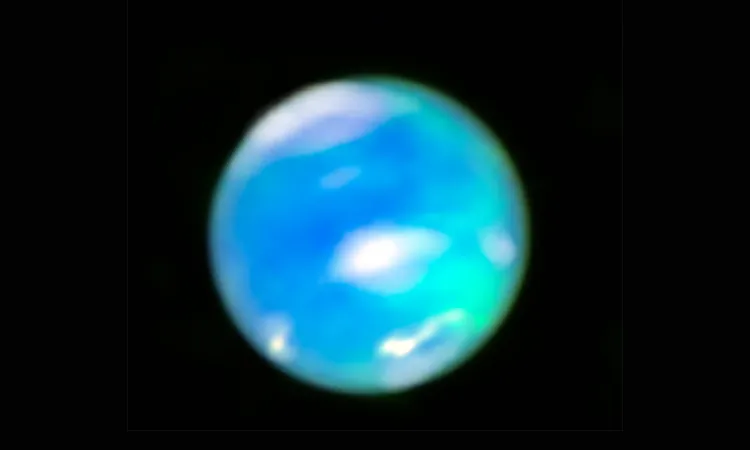
Stunning Breakthrough! Neptune's Auroras Finally Revealed by the Webb Telescope!
2025-04-03
Author: Kai
For the first time in history, Neptune's spectacular auroras have been captured on camera, marking a significant milestone in our understanding of this distant planet! Thanks to NASA's revolutionary James Webb Space Telescope (JWST), astronomers have obtained breathtaking images of auroral activity illuminating Neptune's upper atmosphere.
The groundbreaking data reveals that energetic particles—mainly from the Sun—collide with Neptune's ionosphere, resulting in a dazzling display of light. These particles travel through magnetic fields before they interact with the atmosphere, creating the vivid emissions now visible in Webb's near-infrared images.
While the auroras of neighboring gas giants like Jupiter, Saturn, and Uranus have been previously documented, Neptune’s luminous dance had remained a tantalizing mystery until now.
The Historical Context of Neptune's Auroras
NASA's Voyager 2 spacecraft gave the first hint of Neptune's auroral activity back in 1989 during its flyby, yet subsequent instruments failed to confirm these observations. Despite years of scrutiny using the best ground-based telescopes on Earth, the giant blue planet kept its secrets—until Webb’s advanced technology came into play.
“We finally succeeded in imaging auroral activity on Neptune, and the clarity of these images is simply astonishing,” said lead author Henrik Melin, who conducted the research while affiliated with the University of Leicester.
In June 2023, Webb utilized its Near-Infrared Spectrograph to collect remarkable images and spectral data to analyze the temperature and chemical composition of Neptune's atmosphere. For the first time, researchers clearly detected a strong emission line from H3+, a molecule indicative of auroral activity. This signature was visible as cyan-colored bright spots in the images.
Understanding H3+ and Its Significance
H3+ serves as a pivotal marker for auroras within gas giants, and while widely observed on other planets in our solar system, Neptune's previous lack of data had left its auroras unverified. According to Heidi Hammel, the Webb interdisciplinary scientist at the Association of Universities for Research in Astronomy (AURA), the existence of H3+ confirms what astronomers had long suspected: evidence was not absent, but simply elusive.
A Unique Magnetic Field and Its Effects
In a fascinating twist, Neptune’s auroras appear in the mid-latitudes instead of near the poles, unlike Earth. This phenomenon can be attributed to the planet's magnetic field, which Voyager 2 discovered to be tilted 47 degrees away from Neptune’s rotation axis. This tilt repositions where the field lines converge, causing auroras to be located in unexpected areas, potentially above regions akin to South America on Earth.
Additionally, Webb's findings revealed that Neptune’s upper atmosphere has significantly cooled since the Voyager flyby, by several hundred degrees. This drastic temperature decrease, noted Melin, explains why the planet's auroras had evaded detection for decades. The cooler environment contributes to lighter auroral emissions, adding yet another layer of complexity to this celestial phenomenon.
Future Exploration Opportunities
This landmark discovery paves the way for a captivating new chapter in the exploration of ice giants. Scientists are now preparing to observe Neptune over a complete solar cycle, approximately 11 years, to investigate the effects of solar activity on the planet's magnetic field and its atmosphere.
“As we look forward to potential future missions targeting Uranus and Neptune, it’s clear that we’ll need instruments finely tuned to infrared wavelengths to continue this essential study of auroral phenomena,” said co-author Leigh Fletcher from Leicester University.
The spectacular findings highlight the incredible capabilities of the James Webb Space Telescope and beckon further exploration into the mysterious realms of our solar system’s outer planets.
In a time of unprecedented discovery, these results promise not only to illuminate Neptune's mysteries but also to advance our understanding of the dynamics of planetary atmospheres far beyond our own!
The study's outstanding results are detailed in a recent publication in *Nature Astronomy*.
**Image Credit: NASA**
Stay tuned for more thrilling updates in the world of astronomy and exploration!



 Brasil (PT)
Brasil (PT)
 Canada (EN)
Canada (EN)
 Chile (ES)
Chile (ES)
 Česko (CS)
Česko (CS)
 대한민국 (KO)
대한민국 (KO)
 España (ES)
España (ES)
 France (FR)
France (FR)
 Hong Kong (EN)
Hong Kong (EN)
 Italia (IT)
Italia (IT)
 日本 (JA)
日本 (JA)
 Magyarország (HU)
Magyarország (HU)
 Norge (NO)
Norge (NO)
 Polska (PL)
Polska (PL)
 Schweiz (DE)
Schweiz (DE)
 Singapore (EN)
Singapore (EN)
 Sverige (SV)
Sverige (SV)
 Suomi (FI)
Suomi (FI)
 Türkiye (TR)
Türkiye (TR)
 الإمارات العربية المتحدة (AR)
الإمارات العربية المتحدة (AR)